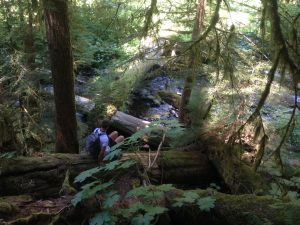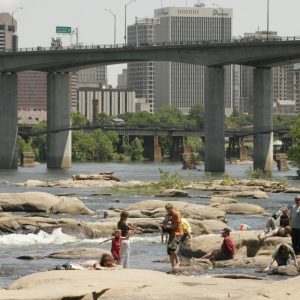Nothing is more natural than wilderness. It exists on the paths we walk every day, in the way plants force themselves into places bricked and paved over, and in our own minds. It’s a way of looking at the world. Imagining wilderness as the sublime, as the antithesis of human interference, serves no purpose other than to lament how the world once was. However, using wilderness as a way of thinking about the world promotes observation and reflection. Here, wilderness has no set definition because to make it objective would be to take away its potency. Instead, wilderness is whatever makes a person feel more connected to the natural world.
When I saw elementary problems in Portland- homelessness, pollution, apathy- I felt deceived. I was expecting trees growing up through the sidewalks, dense forests juxtaposed with offices, and a palpable love for the outdoors. I wish I had read Cronon’s article before visiting Portland. If I had, I may have seen past my disgust at the Cascadian city. I may have seen wilderness in the vegetation along the Willamette, in the city’s identity as a “river city”, and in the complexity of the people of Portland. The authors of Portlandness saw the wilderness of the city when they wrote the section titled “Wildness”. This section exemplifies that perception of wilderness is as much cultural as it is genetic. The sublimity of forests probably wasn’t a consideration for the first residents of the area that is now Portland as they cut down trees to the point that the city was named “stumptown”. The need to earn a living trumped any appreciation of the wilderness, and so the area was cleared. In the past half-century, however, the culture of Portland has embraced wildness. The city has the largest urban natural forested area in the country, and apparently moss “routinely envelops entire cars”.
Wilderness in the H.J. Andrews experimental Forest approaches the traditional definition. It’s easy to see the sublime wilderness in the looming Douglas firs and the dead, woody debris that supports photosynthetic life. It’s easy to see the sublime in the researchers’ goal to preserve the forest and keep it one of the last remaining old-growth stands in the country. However, the researchers, even as the live surrounded by a traditional “wilderness”, embody most of all wilderness as a frame of mind. By working to understand our species’s relationship with plants and with the wild rather than just condemning it, they embrace wilderness as a part of human experience rather than apart from human experience. For them, wilderness is about how to best preserve biodiversity and coexist with nature. Some of the most influential research during the forest wars came from the HJA and focused on the Spotted owl, a species that Cronon actually mentions in his post. He points out the paradox that defenders of biodiversity often have to use a single species, such as the spotted owl, to defend the preservation of an entire ecosystem. For participants in the writers project at the HJA, wilderness was often reflected in simple natural processes. Vicky Graham discussed change by exploring decomposition in the forest . Jeff Fearnside saw wilderness in the contrast between the raging wildness of a flood and the frail stands of willow left after it. By exploring a physical wilderness, they found examples of the frame-of-mind wilderness in their own lives.
The James River Park System, and Belle Isle in particular, embrace the coexistence of wilderness and cities. One of the most valuable functions of city parks is encouraging people to connect with nature in an urban setting. According to Dr. Forsyth’s research, awareness is the first step to action. When people are aware that wilderness doesn’t only exist in the absence of humans, and that it can exist in local parks as well as in grandiose mountain ranges, they are more likely to appreciate the natural world. They are also more likely to keep exploring and learning, and move from the first step of awareness to the second, appraisal. During appraisal, one can better understand wilderness by questioning it rather than just observing. Why is wilderness worth preserving? Where can wilderness be found in unexpected places? In a way, this step is the essence of wilderness as a frame of mind. When appraisal develops into the third step, action, a love for wilderness develops into environmentalism.
My claim that wilderness is a state of mind is intentionally broad. Strictly defining it would remove its meaning, because it’s supposed to be subjective. Appreciation of wilderness is supposed to draw on the context of one’s life, and on the unique way in which they see the world. Wilderness is most valuable as a way of seeing and appreciating the world as it is, for what it is.


